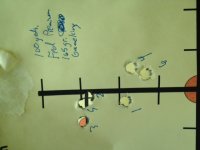big al hunter. . .
I caution folks believing the epoxy bedding instructions and information on
www.ballisticstudies.com being good ones. They fly in the face of the track record of match rifle receiver bedding that's been proved best for decades. Examples. . . .
A pad under the barrel chamber for an inch or so is nothing more than adding a bit of fore end contact to the barrel. As the barrel heats up, it'll press harder against the bedding under the chamber and vertical shot stringing will happen. Follow the benchresters way and have no bedding touching the barrel whatsoever.
That part about square bottomed actions such as the Win. 70 needing relief on their sides. . . If that were true, then why were Win. 70 actions full contact bedded without any clearance able to hold zero much better and make barreled actions shoot more accurate than any totally round receiver that twisted out of good contact in a few hundred round with bullets heavier than 160 grains over at least 45 grains of powder?
misterE. . . .
Barrel length and weight has nothing to do with vertical shot stringing. A given barrel whips the same amount and the same frequency regardless of its temperature; barrel steel's rigidity doesn't change unless it starts to melt at much higher temperatures than they'll be shot at. And a light weight, 2.1 pound, 22 inch barrel's just as stiff as a 4.4 pound, 26 inch, medium heavy barrel.
Barrels change point of impact going from cold to hot because they bend. And they bend because they're not stress relieved correctly after rifling or they're fit to a receiver that's not got a squared up face and there's hard contact at one point around the barrel tenon shoulder.
22 inch light weight M14NM match grade barrels shot the same ammo just as accurate as 26 inch heavy match barrels in bolt guns. 20- to 30- shot strings starting with a cold barrel showed no vertical stringing whatsoever with shots fired 20 to 30 seconds apart. Those barrels got really, really hot.


